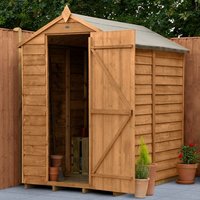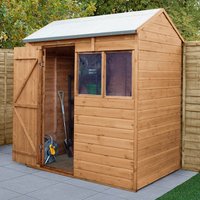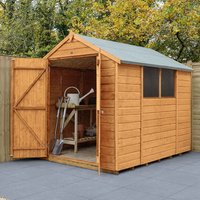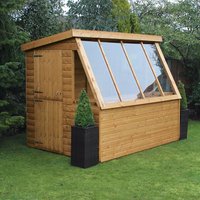Allotment Sheds


Introduction
For many plot holders, allotment sheds are part of the romance of having an allotment. They are somewhere to retreat to, a personal space, a feature to decorate and, perhaps, put up a welcoming sign.
Step By Step Video
YouTube Video
Allotment sheds comes in all shapes and sizes. The two main types are defined by their roof shape:
Apex Sheds
These have a triangular roof shape. The door is often at the side of the shed.
Pent Sheds
The roof on a pent shed is made of one panel that slopes from the front of the shed to the back. Doors are commonly at the front of the shed where the roof is highest.

Both designs have their advantages. Apex sheds are often larger – the roof design is inherently stronger – and these sheds may have a large double door which is convenient for access if storing large items, and also to allow light in. Pent sheds are ideal for placing a work bench along the front side under the window.
In addition, there are potting sheds, which are commonly of pent type, but that feature a large window along the front of the shed, which is useful for germinating seeds and growing on plants in the spring.
Features Of Allotment Sheds
Listed below is a summary of the main features to look for in an allotment shed:
The way the shed is constructed
Feather edge (overlap) sheds have wooden panels that overlap each other. This is a classic shed design, but is often not as strong as shiplap sheds where the panels slot together using tongue and groove joints (as in laminate flooring). There is often a corresponding difference in price, and shiplap sheds often enjoy a longer guarantee of quality.
The size of the doors
Double doors are more convenient than single doors, especially when moving lawnmowers, tables, and other large items in and out of the shed.
The quality of the wood
Nearly all wooden sheds will need additional protection with the application of wood preservation products, typically applied each year in good summer weather.
The size of the shed
On an allotment an 6 ft by 4 ft, or 8 ft by 6 ft, shed is usually sufficient.
Things To Consider Before Getting A Shed
Security
How secure is an allotment? Many allotment holders elect to leave their shed door unlocked, so that if thieves come along they will not damage the shed in the process of stealing. However, if valuable items are to be stored in the shed, the best security may be provided by sheds with a strong single door and frame.
Aspect
If the intention is to use the shed to grow on seedlings on its windowsill, the shed should be positioned to face east to catch the morning sun, or south for the greatest amount of sunshine.
Accessorising a shed
An investment in an allotment shed opens up other helpful possibilities. Including guttering on a shed provides an opportunity to install water butts for rainwater harvesting. In addition, a cold frame can be placed along a sunny sheltered side of a shed.
Shed base
A good shed base is really important for the long term stability of a shed. A wooden shed standing on wet ground will warp and rot – it may also invalidate any lifetime guarantee that comes with a shed. A shed should stand off the ground and allow air to circulate underneath it to avoid damp problems.
Wood source
Look for sheds made with wood from responsibly sourced and sustainable forests, such as those that have received FSC endorsement.
Choosing A Shed Base
The strongest and most durable shed base is a concrete slab (see this video on how to make a concrete shed base).
The base needs to be strong and stable, as any movement of the shed base will have a knock on effect on the stability and strength of the shed itself. Here are some considerations when choosing the shed base:
- Ideally the shed base should allow air to circulate underneath the shed
- Space underneath a shed is a common area where vermin live
(add protection like wire mesh to prevent access) - There may be restrictions at an allotment on the use of concrete or other building materials that are hard to dispose of
If a concrete shed base is too expensive or not practical, there are many DIY alternatives. These can cost between £50 - £100, or more. Some alternatives are as follows:
Standing a shed on paving slabs
This involves marking out an area slightly larger than a shed. Prepare the earth where the shed will stand by flattening it (and step over it to compress the ground). When flat, consider using a layer of weed control fabric to inhibit weeds, before covering with a layer of builder's sand. The slabs are laid upon the sand, using a spirit level to get a flat surface.
Standing a shed on concrete blocks
This method involves digging 10 cm deep channels where the concrete blocks are placed. The shed then stands upon the rows of concrete blocks.
Standing a shed on pallets
Ensure the ground is flat before placing the pallets.
Standing a shed on railway sleepers
Sleepers are a very strong base to stand a shed on, and a shed can be screwed down onto them to help prevent wind damage. Ensure the ground is level before placing the sleepers.
Standing a shed on plastic pavers or grids
The ground will need to be prepared to create a flat surface, and compressed either by a roller or by repeated walking over. The pavers can then be laid on top and filled with soil, sand, or small gravel to create a strong base.
Featured Sheds
The easy way for a gardener to organise their growing and discover gardening ideas.




